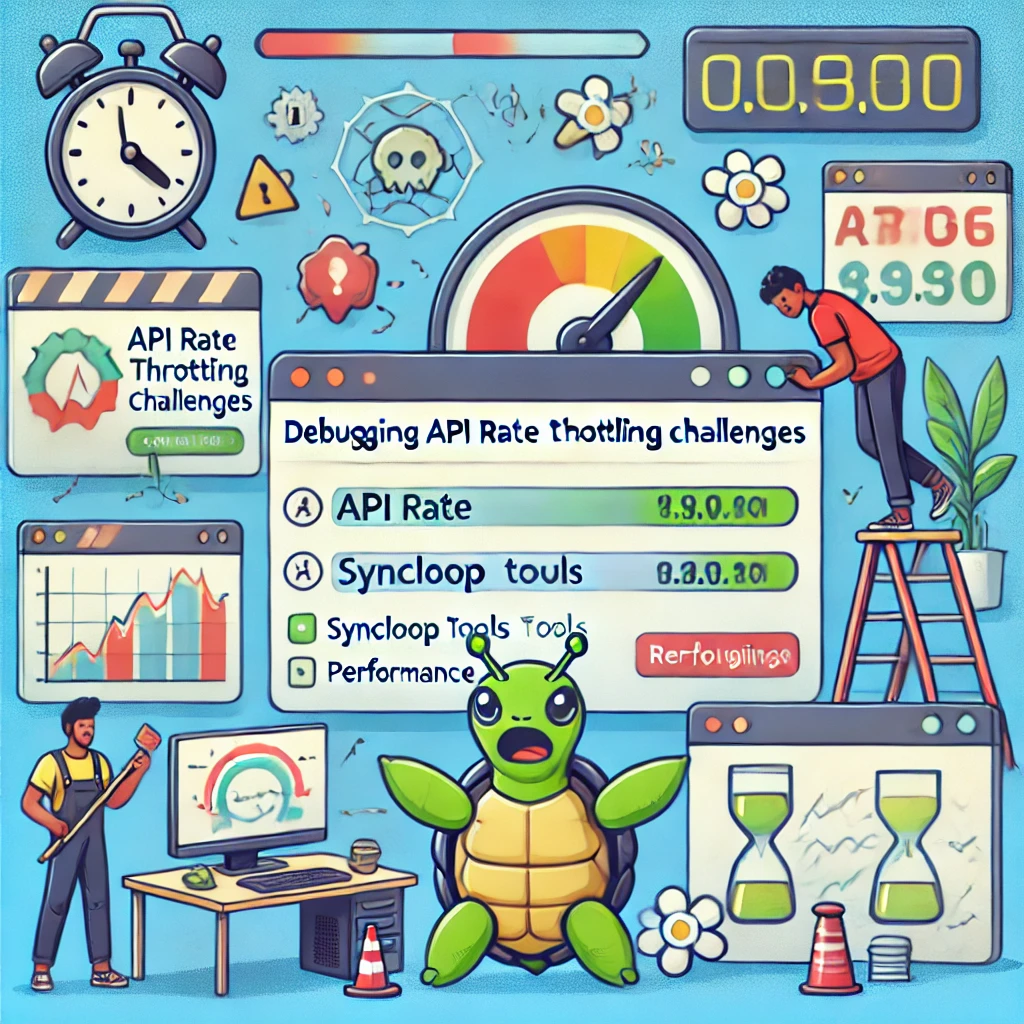Debugging API Rate Throttling Challenges with Syncloop Monitoring Tools

Syncloop provides advanced monitoring tools to help developers identify, analyze, and resolve rate throttling challenges. This blog explores the common throttling issues, how Syncloop’s monitoring tools can assist in debugging, and best practices for maintaining effective API rate limits.
The Importance of API Rate Throttling
Rate throttling helps to:
- Protect Resources: Prevent overuse of backend systems.
- Ensure Fair Usage: Enforce quotas for API clients to maintain equitable resource distribution.
- Optimize Performance: Balance loads to maintain consistent response times.
- Prevent Abuse: Mitigate risks such as bot attacks or denial-of-service (DoS) threats.
- Support Scalability: Manage increasing traffic effectively by limiting individual client usage.
Common Challenges in API Rate Throttling
- Unexpected Request Rejections Legitimate requests may be denied due to misconfigured limits or bursty traffic.
- Inconsistent Enforcement Rate limits may vary across different endpoints or clients, causing discrepancies.
- Latency Impacts Throttling mechanisms can introduce delays in processing requests.
- Quota Exhaustion Issues Clients may unknowingly exceed their allocated quotas due to lack of feedback or visibility.
- Monitoring Gaps Insufficient logging and analytics make it difficult to diagnose throttling-related issues.
How Syncloop Simplifies Debugging Rate Throttling Challenges
Syncloop provides robust tools to address these challenges:
- Real-Time Monitoring Visualize API traffic, request rates, and throttling events in real time.
- Detailed Logs Access granular logs to analyze rejected requests and identify affected clients.
- Rate Limit Configuration Define and manage throttling policies dynamically for specific endpoints or clients.
- Error Detection and Alerts Detect anomalies, such as excessive rejections or inconsistent throttling, and trigger alerts.
- Quota Usage Analytics Track quota consumption by client or endpoint to identify patterns and optimize limits.
- Testing and Validation Simulate traffic patterns to validate throttling rules and ensure consistent enforcement.
Steps to Debug Rate Throttling Issues with Syncloop
Step 1: Monitor Traffic in Real Time
Use Syncloop’s monitoring tools to:
- Visualize API traffic patterns and identify peaks.
- Track the number of requests accepted and rejected due to throttling.
- Detect anomalies in traffic that could indicate throttling misconfigurations.
Step 2: Analyze Logs for Rejected Requests
Access Syncloop’s detailed logs to:
- Identify the endpoints or clients experiencing high rejection rates.
- Review timestamps and payloads of rejected requests.
- Pinpoint misaligned rate limits or bursty traffic causing rejections.
Step 3: Adjust Throttling Policies
Use Syncloop to configure rate limits that align with client needs and backend capacity:
- Define per-client or per-endpoint quotas for granular control.
- Implement burst handling to allow temporary traffic spikes without rejection.
- Set global rate limits for overall traffic management.
Step 4: Implement Quota Feedback Mechanisms
Configure Syncloop to:
- Return appropriate HTTP status codes (e.g., 429 Too Many Requests) with retry-after headers.
- Notify clients when they approach their quotas to prevent overages.
Step 5: Validate and Test
Simulate traffic scenarios using Syncloop’s testing tools to:
- Verify that rate limits are enforced consistently across clients and endpoints.
- Ensure burst handling and fallback mechanisms work as expected.
- Validate latency impacts and overall API performance under throttling.
Step 6: Monitor Post-Implementation Performance
Continue monitoring to:
- Track changes in rejection rates and client behavior.
- Analyze quota usage patterns to refine rate limits.
- Identify and address emerging issues proactively.
Best Practices for Effective Rate Throttling
- Define Clear Policies Ensure rate limits align with backend capacity and business priorities.
- Enable Client Feedback Provide transparent information about quotas and remaining limits in API responses.
- Monitor Continuously Use Syncloop’s real-time monitoring to detect and address throttling-related issues quickly.
- Use Granular Controls Apply different rate limits for distinct clients, endpoints, or use cases to optimize resources.
- Document Rate Limits Clearly communicate throttling policies in API documentation to set client expectations.
Example Use Case: SaaS Platform API
A SaaS platform uses Syncloop to manage rate throttling for its APIs:
- Real-Time Monitoring: Tracks traffic spikes during peak hours and adjusts limits dynamically.
- Detailed Logging: Analyzes rejected requests from clients exceeding their quotas.
- Quota Alerts: Notifies high-usage clients to prevent unintentional overages.
- Granular Policies: Applies different rate limits for free-tier and premium clients.
- Testing and Validation: Simulates high-traffic scenarios to validate throttling rules before deployment.
Benefits of Using Syncloop for Throttling Management
- Improved Efficiency: Balance traffic loads and maintain consistent performance.
- Enhanced Visibility: Gain actionable insights into throttling events and client behavior.
- Reduced Errors: Minimize unintended rejections and ensure consistent enforcement of limits.
- Proactive Management: Detect and resolve throttling-related issues before they impact users.
- Scalable Solutions: Adapt rate limits dynamically to meet changing traffic demands.
The Future of API Rate Throttling
As APIs continue to support diverse and high-traffic applications, effective throttling will be critical to ensure stability and scalability. Syncloop equips developers with tools to manage and optimize rate limits, providing secure and efficient API interactions for clients and backend systems alike.
Image Description
A conceptual illustration showcasing Syncloop’s tools for debugging API rate throttling challenges, featuring real-time monitoring, quota usage analytics, and error detection. The image highlights optimized traffic management and scalable API performance.
Back to Blogs